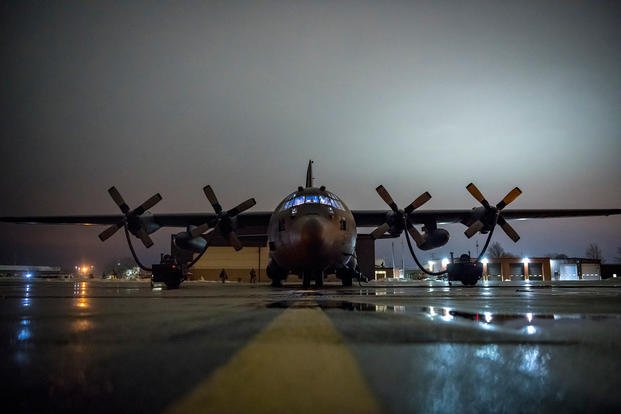The U.S. Air Force believes it can sustain and upgrade 92 of its oldest C-130 military transport aircraft even as it aims to downsize the overall Hercules fleet over the next few years, according to top brass.
During a Senate Armed Services Airland subcommittee hearing Tuesday, the Air Force reiterated budget plans to reduce its C-130 fleet to 255 aircraft in the near future from about 300 currently.
Of those 255, 163 would be newer J-models the service already has or are on order from Lockheed Martin Corp., said Lt. Gen. David Nahom, deputy chief of staff for plans and programs, adding that 92 older H models would receive necessary modifications to keep them viable. He first disclosed these figures at a House Armed Services Subcommittee on Seapower and Projection Forces hearing earlier this month.
Read Next: Seven Top Generals Object to Taking Military Prosecutions Out of Commanders' Hands
"To get to 255 is a stretch goal. That's if we can get that with mutually agreeable replace missions," Nahom said. He was referring to state National Guard and Reserve units that fly C-130s someday transitioning to a new mission. Nearly half of the service's current C-130 aircraft, or 149, are flown by the Guard, according to an Air National Guard fact sheet.
"And we may not get there. We understand that, but we believe that 163 is a good number," Nahom said. J-models typically have new engines and better propellers; they also have more lift capability, can fly faster and have a longer range.
The service also maintains some special mission C-130s -- such as EC-130 airborne communications jamming aircraft and the LC-130 "Skibird," which can land on ice and snow for Antarctic missions. It was not immediately clear how these aircraft would be affected by the potential fleet downsizing. However, in its fiscal 2022 budget request, the Air Force is already looking to mothball 20 of the oldest C-130 Hercules transport H-models, which includes two EC-130H and five MC-130H special operations aircraft.
As the service brings in new C-130J models, it will incur additional costs to sustain those aircraft in the future, Nahom said. "That comes obviously at an added cost to what we can do with that money for other areas that we're frankly carrying greater risks than on the C-130," he added.
The C-130 serves as the airlift workhorse for supply missions around the world, largely due to its tactical advantage: Much more flexible and agile than its larger cousin, the C-17 Globemaster III, the C-130 can carry approximately 45,000 pounds and airdrop loads up to 42,000 pounds.
C-130s also have been reconfigured for crucial missions stateside, such as the Modular Airborne Fire Fighting System to battle wildfires; the Modular Aerial Spray System aircraft to spray for pests such as mosquitoes; and the WC-130 "Hurricane Hunter" aircraft for weather reconnaissance.
Last month, Lt. Gen. S. Clinton Hinote, the Air Force's deputy chief of staff for strategy, integration and requirements, said lumbering C-130s might be vulnerable as they deliver supplies or transport personnel during a near-peer conflict.
Instead, the Air Force should look to more innovative solutions, such as a high-speed vertical takeoff and landing aircraft, he told Military.com in an interview. He made similar comments during the seapower and projection forces hearing earlier this month.
"[The] C-130 capability is not well-suited to address this risk," Hinote said during that panel. "That's why we feel we need to retire a certain number of the older C-130s, while addressing this airlift risk in new ways, with new capabilities."
In May, Army Gen. Daniel R. Hokanson, head of the National Guard Bureau, told lawmakers he's against sizable C-130 cuts just for the stateside missions alone.
The Guard must "retain every single one of those flying squadrons because of what they bring for our nation," he said during a May 4 House Appropriations Defense subcommittee hearing.
Senators haven't jumped to support a potential cut, nor have they been quick to back high-speed vertical takeoff and landing aircraft or other innovative solutions as a trade-off for more modernized equipment.
Instead, Sens. Dick Durbin and Tammy Duckworth, both Illinois Democrats, have urged the Senate Appropriations Committee to support the procurement of extra C-130Js, known as the Super Hercules, for the Air National Guard.
"We support strong funding for the quick modernization of all Air National Guard and Air Force Reserve C-130H aircraft that are not recapitalized with the newer C-130J models," they said in a June 4 letter to the committee with nine other signatories.
The service has asked for five new C-130Js this budget cycle. Durbin and Duckworth want "at least eight additional" aircraft, according to the letter.
"Such robust funding will help our brave service members have the best, newest equipment to provide for their safety, as well as our vital airlift capability and national security needs," they wrote.
-- Oriana Pawlyk can be reached at oriana.pawlyk@military.com. Follow her on Twitter at @oriana0214.
Related: Air Force Returns C-130s to Flight After Safety Inspections












